Analyzing Intel Core M Performance: How 5Y10 can beat 5Y71 & the OEMs' Dilemma
by Brett Howse & Ian Cutress on April 8, 2015 8:00 AM EST3DMark Ice Storm Unlimited Results
Ice Storm Unlimited is quite a bit different than the last two benchmarks. The test is built for smartphones and tablets, so is far less demanding than the other GPU benchmarks. There are two GPU tests, and a physics test, and as you will see in the graphs, when those workloads are occurring is very obvious. The overall benchmark is quite short though, which allows the devices that have more thermal issues, but higher overall turbo frequencies, to keep the frequencies up much more. It is basically the equivalent of a CPU burst workload, except mostly run on the GPU.
The Core i5 does not even flinch at this workload, even leveraging its turbo when needed. The Venue 11 Pro is the most interesting graph because it so clearly defines when the actual work is happening. Because the duration is so short, it is able to turbo quite high, and the GPU frequencies are not throttled too much. The ASUS does have to throttle the CPU to keep the GPU frequency up on this test. The Yoga 3 Pro shows quite a strong result in this very short test.
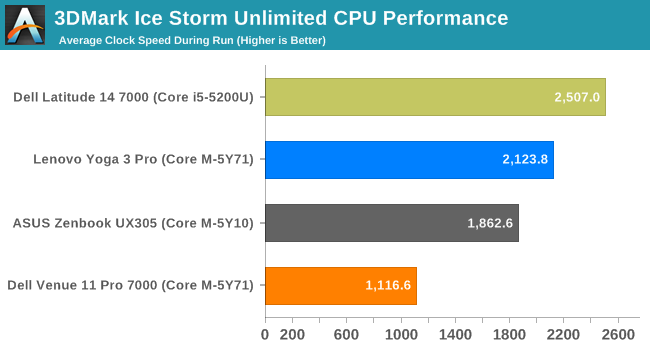
Looking at the average CPU speeds, the Yoga 3 Pro jumps way out in front. The Venue 11 Pro is quite far behind, but as you can see in the graphs, when the work was required, it did have thermal headroom available to turbo.
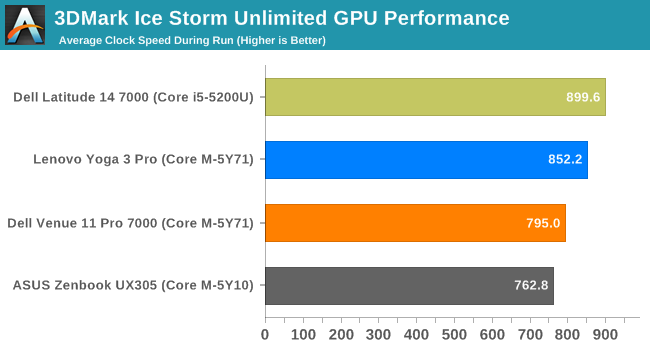
On the GPU front, the Yoga 3 Pro is almost at the same average as the Core i5 in this test, as both have the same base and turbo frequencies. The Venue 11 is only a bit behind, and the ASUS falls to third due to the 100 MHz frequency deficit that the 5Y10 has on the GPU compared to the 5Y71 processor.

On the SoC temperature side, none of the devices struggle with temperature on such a short test.
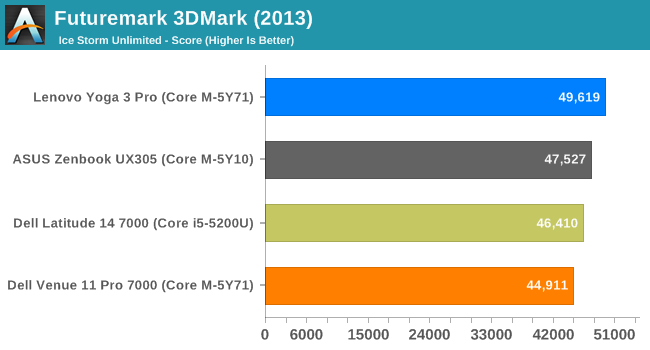
On such a short test, the Core M devices all do very well, and the fastest Core M model in the Yoga 3 Pro tops this GPU test. It is quite a bit in front of the rest of the devices, showing that with active cooling, it can still get a lot of work done in a short amount of time. Remember that the Core i5 Dell Latitude is the only device with single-channel memory, which hurts it most in the GPU tests and explains why it is below the Core M devices despite much higher average frequencies for both the CPU and GPU.


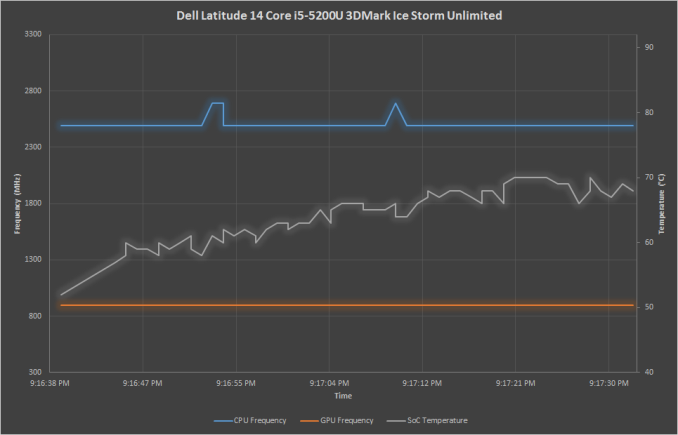
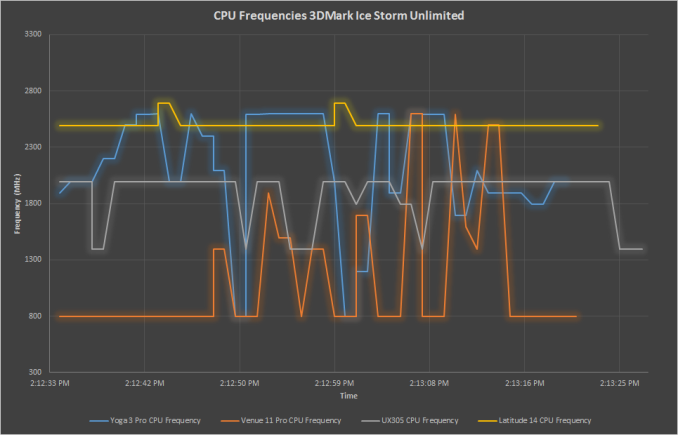
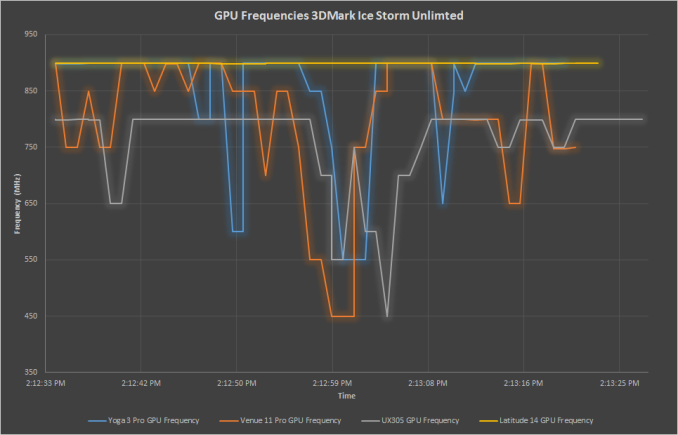









110 Comments
View All Comments
serendip - Wednesday, April 8, 2015 - link
Core M is expensive for what it does. If you want mobility without a fan, go with Atom. If you want better unthrottled performance, go with the U models.It's the weird throttling and poor OEM thermal designs which concern me. Core M may have good turbo speeds but that's useless if it has to throttle down quickly from heat soak. Users will be disappointed when their machines act speedy one moment and start lagging the next, no matter what the design turbo speeds are.
serendip - Wednesday, April 8, 2015 - link
Can't edit comments, sigh. Anyway, my Bay Trail Atom tablet runs from 600 MHz to 1.86 GHz and has no issues with thermal throttling. It can smoothly turbo and then clock down without dropping down too far and sacrificing usability.It seems some OEMs like Lenovo set a total system power draw limit that's too low, on top of skin thermal limits. The CPU can only turbo for very short periods of time before being dropped to base speed or even lower. You're then stuck with a 1 GHz CPU and 100 MHz GPU which you paid a ton of money for. I think the problem lies with both sloppy engineering from OEMs and unrealistic promises made by Intel.
nonoverclock - Wednesday, April 8, 2015 - link
I have a Bay Trail Atom (Venue Pro 11) and it's alright but I definitely need more speed. Trying to stream sports games through their Metro apps will often skip and this doesn't happen on my higher performance devices. Also it has some inexplicable pauses here and there. More speed would be great.Brett Howse - Wednesday, April 8, 2015 - link
I think you are missing the fact that even throttled Broadwell is a lot faster than Silvermont cores. I don't have the T100 in the notebook bench (it is a tablet) but the HP Stream has two Silvermont cores and a 7.5 watt TDP http://anandtech.com/bench/product/1449?vs=1400If you want to compare to quad-core Bay Trail some of the scores are here http://anandtech.com/show/7428/asus-transformer-bo...
Bay Trail was a big boost for Atom but I would take Core M in a mobile device over it any day.
Pissedoffyouth - Thursday, April 9, 2015 - link
My bay trail Asus T100 never throttles back from 1.8ghz even under prime95+furmark. very power efficientsonicmerlin - Wednesday, April 8, 2015 - link
I really like this article, but I wish you had run GFXBench, which is more of a pure GPU test. I want to compare the results to the iPad's A8X and Tegra K1.Brett Howse - Wednesday, April 8, 2015 - link
I have discussed this in the actual device reviews. This article wasn't about that kind of comparison so I will ask you to go to the review http://anandtech.com/show/9104/asus-zenbook-ux305-...testbug00 - Wednesday, April 8, 2015 - link
All this testing, and, I don't see a single power system power draw number for anything. Maybe I'm missing something? But, woudn't seeing the i5 system draw 7-13 watts more be useful for determining how good Core M is?If the product uses a third of the power and gets 50-100% of the performance... Well. That's very impressive.
Alexvrb - Wednesday, April 8, 2015 - link
Do you like phystics? Do you like phystics in your mouth? (typo on page 2!)Brett Howse - Thursday, April 9, 2015 - link
TYVM :)